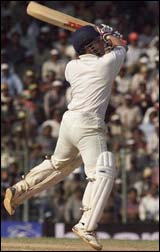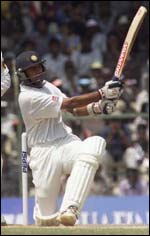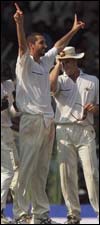

It's even, Steven!
Prem Panicker
Magnificient pace and spin bowling. Grim, determined batting by a player known to be a dasher, dashing strokeplay by Mr Conservative. 279 runs scored over 90 overs, for the loss of 8 wickets. And, after three days of hard combat in extremely hot and humid conditions with neither side giving an unnecessary inch, a game that is as evenly balanced as you could wish for.
If Test cricket can be this taut, this thrilling, then why on why do we insist on playing so many one-dayers?
India went in this morning on 211/1. And Australia went in on the defensive, with Glen McGrath opening the bowling with just one slip in place for Shiv Sunder Das. And off the very first ball, being bowled with a ball 64 overs old, the Aussie frontman produced a superb reverse swinging delivery on very full length. Das, perhaps, erred in attempting an across the line flick before he had time to get his eye in -- as it turned out, he played around the line, beaten for length and movement, took it on the pad, and found his fine, fighting innings abruptly terminated.
 That brought Sachin Tendulkar to the crease to face the second ball of the morning. At the other end, Laxman played another of his easy drives on the up through covers, and seemed to be continuing his form of Calcutta. McGrath, however, held his line just outside off, Steve Waugh brought in an extra slip and like Das, Laxman played that one shot too many and too early, driving on the rise at a McGrath delivery that left him just enough for Mark Waugh, at second slip, to yet again demystify the art of slip catching.
That brought Sachin Tendulkar to the crease to face the second ball of the morning. At the other end, Laxman played another of his easy drives on the up through covers, and seemed to be continuing his form of Calcutta. McGrath, however, held his line just outside off, Steve Waugh brought in an extra slip and like Das, Laxman played that one shot too many and too early, driving on the rise at a McGrath delivery that left him just enough for Mark Waugh, at second slip, to yet again demystify the art of slip catching.
Then followed the one period of play that was almost completely devoid of aesthetic values. Sourav Ganguly, perhaps feeling the weight of repeated failures with the bat (an explanation that is infinitely preferable to the other one that the media keeps skirting around), found himself ringed by three slips, two gullies to pace, and by a four-man close cordon to spin -- and showed a complete absence of form.
True, he has his problems against pace, and Jason Gillespie in particular exposed it with a fiery spell during which one particular ball, jumping off a length, almost had Ganguly fending it to gully. But what was painful to watch was his batting to the spin of Warne and more particularly, Miller. Gone was the quicksilver footwork, gone too the silky driving through the line. Instead, we were treated to the spectacle of Ganguly -- who generally treats off spinners with lordly disdain -- struggling against the quickish spin of Miller.
With the captain struggling at one end, Sachin Tendulkar promptly downed shutters at the other end, seemingly intent on ensuring that there was no breakthrough. The Aussies for their part bowled and fielded their hearts out, with Gillespie being particularly outstanding. Lunch was taken with Sachin batting 27 off an uncharacteristic 89 deliveries, Ganguly 14 off 61, India 266/2 on the board, and 55 runs having been added in 28 overs for the loss of two wickets. Incredibly, not a single one of those 28 overs was bowled by Warne, Waugh at one point tossing the ball to Ricky Ponting for a couple of overs while Warne stayed at slip.
The Calcutta Test has produced a bit of fun and games. Glenn McGrath, walking back to his mark at one point, found Sourav Ganguly at the non-striker's end, and 'politely inquired about the well being of his friend'. Ganguly, surprised, replied with a warm smile and a 'Fine, thanks'. A ball later, a run was taken, Ganguly got to the business end, McGrath went round the wicket, pitched one off, lifted it off length, Ganguly defended, and was taken off the edge.
This time, no words were exchanged. McGrath went round the wicket again to Ganguly, hit that same line and the Indian captain, whose feet had stayed nailed in place all morning, drove without footwork, got the edge, and the McGrath-Gilchrist combination went into their celebratory dance again. The Ganguly-Tendulkar partnership had produced 47, off 158 deliveries, without ever looking likely to go any great distance.
 That brought Rahul Dravid to the wicket. Given past record, you would have expected the play to get grimmer, for the defence to get dourer, for us to be treated to long periods of defensive play. What we got, instead, was a 50-run association off just 67 balls -- and that was only the beginning.
That brought Rahul Dravid to the wicket. Given past record, you would have expected the play to get grimmer, for the defence to get dourer, for us to be treated to long periods of defensive play. What we got, instead, was a 50-run association off just 67 balls -- and that was only the beginning.
Dravid began with a series of flowing drives, on the off to pace and on the on to the spin of Warne. But more importantly, both batsmen settled down to rapidly rotate the strike with good calling and running to finely judged placements, and suddenly, the innings was in overdrive.
The demotion to number six appears to have freed whatever mental block Dravid was suffering from -- the batsman on view today (and earlier, in the Calcutta second innings) was the exact opposite of the 'Wall' that seemed of late to have developed cracks in it. Unruffled, imperious -- a crashing on-driven six off Gillespie being particularly reminiscent of the one hit off Donald at Durban -- Dravid revealed another side to his batting and yet again, had you wondering why he keeps this style of play in mothballs, bringing it out only occasionally like some rare, treasured shawl for a state occasion.
The partnership, at rollicking pace, took India in to tea at 378/4. Tendulkar at the time was batting 77, Dravid 48. During the post lunch session, 112 runs had been scored off just 28 overs. And the pressure was once more telling on the Australians.
That pressure was exemplified by a little incident, when Sachin Tendulkar -- who through the session continued to bat in sedate fashion, only occasionally indulging himself with some trademark punches on the off and some power-packed swats on the on side off the two spinners -- halted McGrath in mid runup, thanks to some movement behind the sightscreen.
A ball later, McGrath was seen going up to Sachin and suggesting that he go around the stadium, asking every single spectator to sit down. The next over saw a series of short-pitched deliveries, Sachin repeatedly swaying away from line. After three of those, McGrath went down the track and gesticulated, inviting -- daring? -- Sachin to play the hook. Along came another bouncer, Sachin ducked, then held McGrath's eye. Last ball, short again, McGrath follows through then says something -- and for once, Sachin says something polite right back.
The heat -- and not all of it caused by the sun -- was seemingly getting to everyone.
Post tea play began with McGrath opening the bowling. The first ball was short, and Dravid pulled. Four. 52 off 77 balls. Another short ball, another pull. And the tone was set once more.
Sachin, with checked drives and the occasionally firm pushes, had meanwhile got into his 80s when Miller was brought back on. To a ball wide of off, Sachin went low on his knees, got under it, and played a lofted shot, looking to clear midwicket. At that point, the second new ball -- taken very late -- was just 8 overs old, Miller got it to bounce higher, got the top edge and Slater, posted on the fence at midwicket, seemingly had it covered.
Slater came running in easily, got to the catch -- and then unaccountably, lost his head and did a little exuberant hop that saw the ball slip through his hands. Premature celebration -- of the kind famously indulged in by Herschelle Gibbs -- had proved costly yet again.
How costly, was indicated shortly thereafter, when off the first ball of another Miller over, Sachin again went low, got his bat under the ball, and smashed one back down the track from outside line of off, clearing the field for a six to jump from 94 to his 25th Test century (incidentally, drawing level with Steve Waugh who had notched up his own 25th in the previous game).
The century had come off 197 balls, with 11 fours and two sixes -- an uncharacteristically subdued knock, with Tendulkar seemingly content to spend time in the middle, keep the board ticking over, and look to bat on and on.
 At the other end, Dravid was coasting along with effortless strokeplay. Jason Gillespie -- who must take a size 20 or so in hearts -- kept firing them down as fast as you want to imagine, and one such snorter hitting middle and darting down to leg saw Dravid, then 81, flicking to get the glove. Gilchrist dived, got his hand to it, and spilt the chance. Gillespie's expression (the dropped chance had come just three balls after Dravid had smashed that six off the fast bowler) was worth a thousand words, not one of them the kind you want to print here.
At the other end, Dravid was coasting along with effortless strokeplay. Jason Gillespie -- who must take a size 20 or so in hearts -- kept firing them down as fast as you want to imagine, and one such snorter hitting middle and darting down to leg saw Dravid, then 81, flicking to get the glove. Gilchrist dived, got his hand to it, and spilt the chance. Gillespie's expression (the dropped chance had come just three balls after Dravid had smashed that six off the fast bowler) was worth a thousand words, not one of them the kind you want to print here.
The let off, though, did not prove particularly costly. An over later, Gillespie bowled one outside off, sending it through at speed, Dravid flashed into the cover drive he had been playing superbly all afternoon, failed this time to really get his front foot right across into the shot, and nicked through for Gilchrist to hold.
And then, off the very next ball, Jason Gillespie produced the ball of the match. Dighe took strike, Gillespie ran in, and the ball whooshed past the startled batsman at an astonishing 149.1 kmph before he even had time to react.
At the other end, Warne and Tendulkar got into a little match of their own. With Ponting at short fine leg, Warne took to pitching outside leg. A paddle sweep fetched Sachin four. Another paddle sweep was superbly stopped by Ponting. A third, fetched four again. Warne, in frustration, sent down a bouncer from around the wicket. Sachin first ducked, then suddenly jumped off the ground and with his bat facing up, hit it over the head of slip and down to third man for four -- adding insult to injury by sharing a joke and a laugh with Gilchrist after playing the shot.
Typically, however, the adrenalin that seems to invade him once he is past his century (longevity at the crease is a lesson he needs to learn yet -- and Laxman just might be the ideal teacher) had him flashing into a cut a seemingly innocuous Gillespie delivery outside off. The ball stayed a bit low, found the edge, and Gilchrist stayed low to take a nice catch to the ball dying on him.
India 468/6, and the game had turned on its head again. Australia, punch-drunk and reeling at tea, bounced back into the game and went on a wicket hunt. Warne went back over the wicket, and produced a well-disguised arm ball. Samir Dighe played for the leg break, took it on the pad, and walked back.
Colin Miller -- who by then had overtaken Warne, with 150+ off his 44 overs -- then held one back, and Zahir Khan obligingly tapped it back to the bowler. Harbhajan, later in the same over, tapped a tame catch to slip -- and while walking back, must have been hoping/wishing that he could get wickets as easily.
Sairaj Bahutule, looking quite untroubled, and Nilesh Kulkarni, looking the reverse, saw India through to a closing score of 480/9. The final session of play had produced 102 runs off 34 overs. Crucially, five wickets had also fallen and India, at tea looking as though it had the game in its hands, had thrown it all wide open again.
India are now 89 runs ahead, with one wicket left standing. And there are 180 overs left to play. So where does this one go?
Steve Waugh wants to win. At all times conscious of history, he has been making repeated references to the Final Frontier, and to the fact that Australia hasn't beaten India in India for over three decades now. India, on the other hand, will probably feel content to draw a series against the unofficial world champions, and take pride in having halted the seemingly irresistible force.
Which means that it is now Australia that has to make all the running. To force a win, Waugh and his lads have to score enough runs to be able to put pressure on the Indians. How much is enough on this track? 250? To get there, the Aussies have in fact to score 339.
But at what rate? There are large areas now on the pitch where the top has come off. They are precisely the kind of conditions Indian spinners revel in, and know how to exploit. Against this, the Aussies will have to score at something like 3.4 an over to get 250 ahead and still leave at least 80 overs to try and bowl the Indians out in the last innings. And they have to try, with the constant awareness that a couple of early wickets lost in the chase for runs could expose a brittle middle order -- and swing the game yet again towards the home side.
It's the heck of a highwire act facing the Australians on day four -- and could produce yet another crackling day of Test cricket on day four. Amazing, really, that after three hard-fought days, all three results -- a win by either side, and a draw -- are still very much possible.
But hey, while on highwire acts -- just for fun, let's try some of our own. Australia will not win this game. The odds are 45 per cent for a draw, 55 per cent for an Indian win. And besides Tendulkar and Harbajan, the unsuspected dangerman with the ball in the second innings could be Nilesh Kulkarni -- whose forte is bowling on a cracking pitch in the second innings.
The above could go horribly wrong, and leave me with an egg-pack on my face -- but then, what's life without a little calculated risk?
Scoreboard
Commentary Transcripts:
Morning session | Post Lunch | Post Tea
Mail your comments